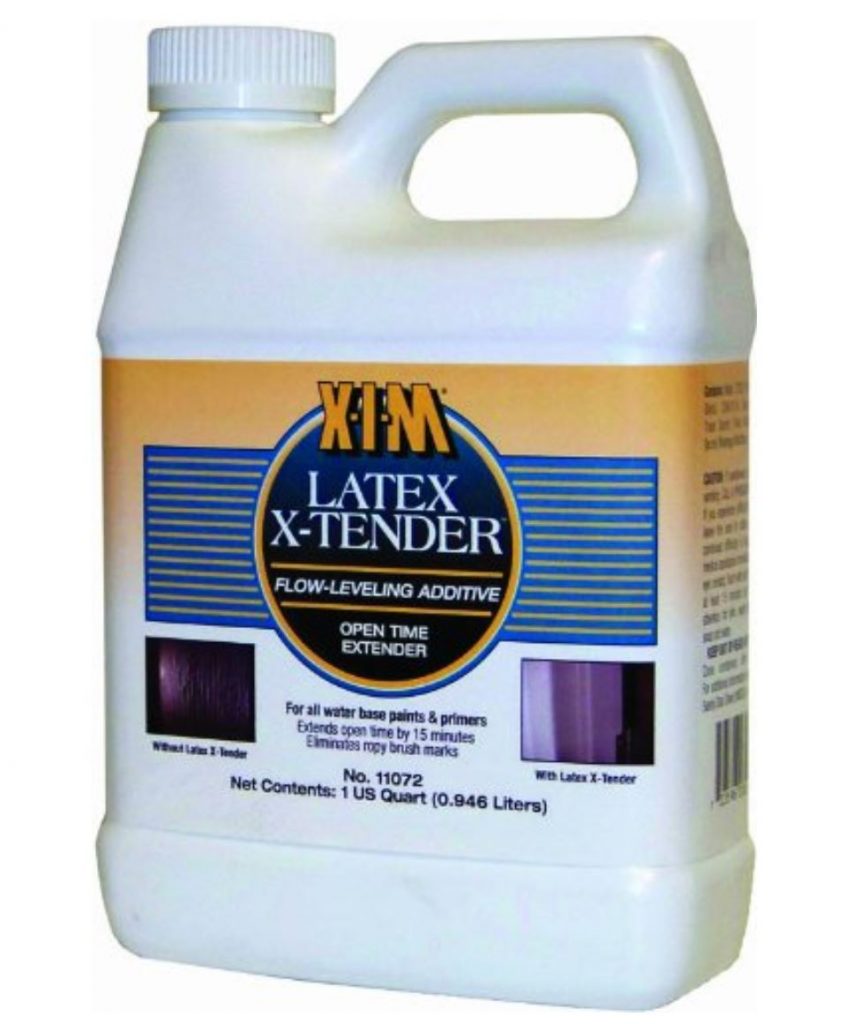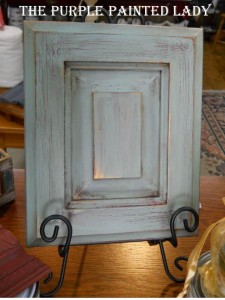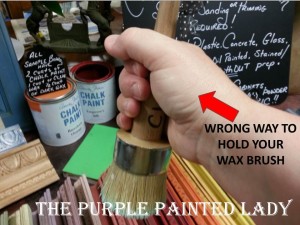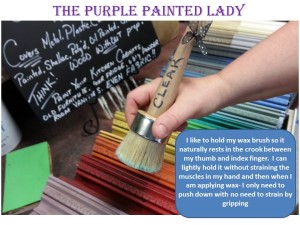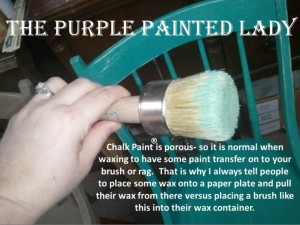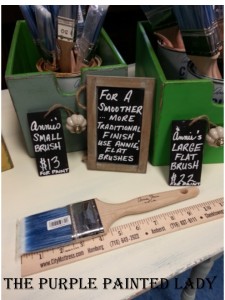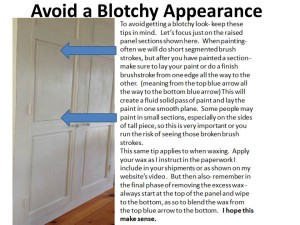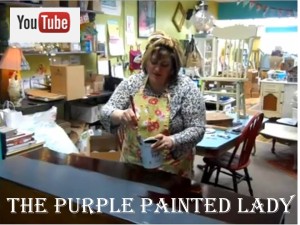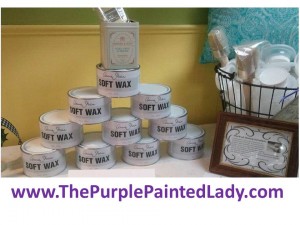Paint Your Dark Cabinets……..don’t be afraid because The Purple Painted Lady is here to help you!
Here is a photo from our customer Loretta McKinley who painted her dark black cabinets with Coco Chalk Paint® by Annie Sloan and used dark wax.
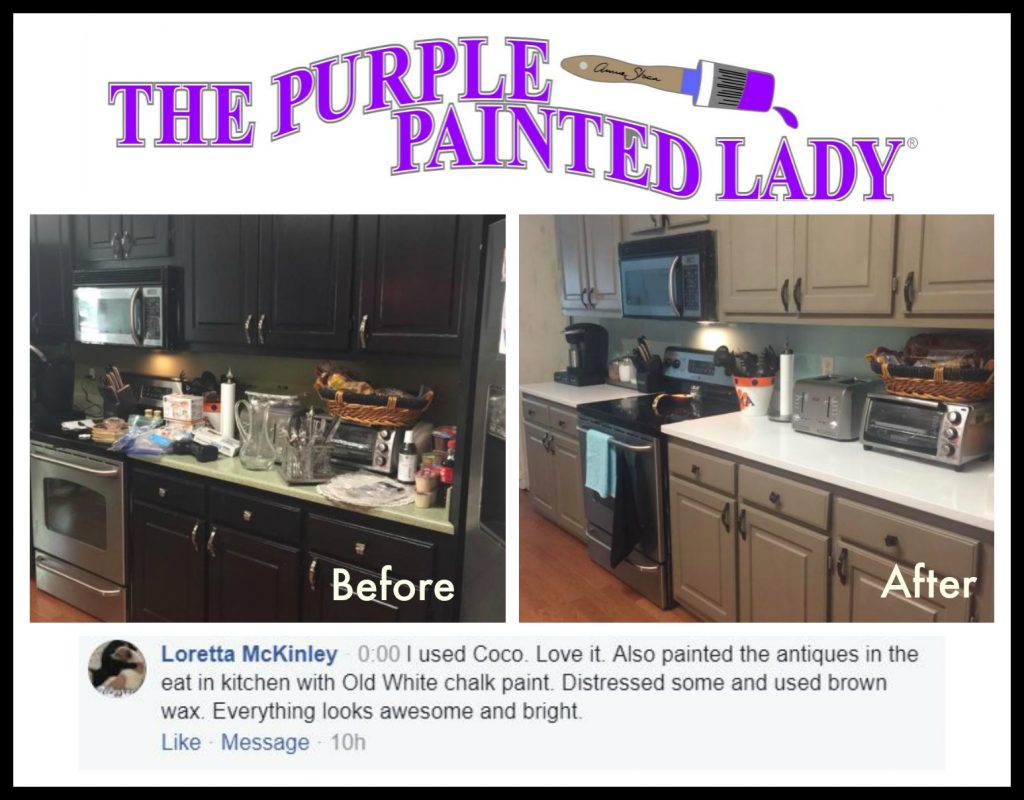
Below are a couple of links to full length tutorial and intense information for painting your cabinets. The videos are literally like taking a workshop with The purple Painted Lady, but …..instead they are free.
After having my shop for 8 years and have helped literally, thousands of people transform their dark cabinets to something lighter, brighter and fresh…. all of us at The Purple Painted Lady are here to help you too!
I know the feeling – it is almost like depression when you walk into a room of your home that is dark and that you do not like. How long are you going to live like that? There is no reason to not change it because:
- it’s affordable! For an average size kitchen, you can purchase your product and tools to transform it for under $300!
- it’s okay to paint wood…especially if you do not like it! Life is short…eat the cake! But more importantly, painted cabinets are more appealing during resale.
- you will be happier living in your space….and why shouldn’t you like where you live?
TIPS to think about before beginning any cabinet painting project:
• Become familiar with your painting technique. If painting cabinets is new to you, consider painting a small piece of furniture first to get used to applying both the paint and wax. It can also be helpful to have a small scrap piece of wood available in your workspace as a surface on which to test each step of your process before proceeding to the cabinets.
• If you are painting with a custom color, be sure to mix enough paint for the entire job.
• Paint in the way the cabinet doors are constructed. If the doors are typical five-piece construction, paint the center panel first and then proceed to the rails and stiles, using the brush to create a nice line where the rail joins the stile. Use even brush strokes and don’t overload the brush with paint. When painting the rails and stiles, start painting on the outer edges and work your way in towards the center panel to avoid excess paint pooling where the panel joins the other components.
• To help ensure a consistent look, complete each step of your finish across all of your cabinets before proceeding to the next.
• Chalk Paint® is a thick paint. Load your brush, get it on and with a light touch feather it out. It does not like to be played with for an extended time!
Now, we have a bunch of posts here on our website sharing tips and tricks and instructions on how to paint your cabinets, but this week we decided to share some real life video! So, catch us on our YOUTUBE channel while we paint the cabinets shown below with Old White Chalk Paint® by Annie Sloan.
Video ONE (this contains the nest tools to be using, how to prep properly, and first coat application)
Video TWO (this contains tips for applying a second coat and your first coat of wax) Jump to the 14 minute marker to skip some of the review if you are not a patient person. LOL
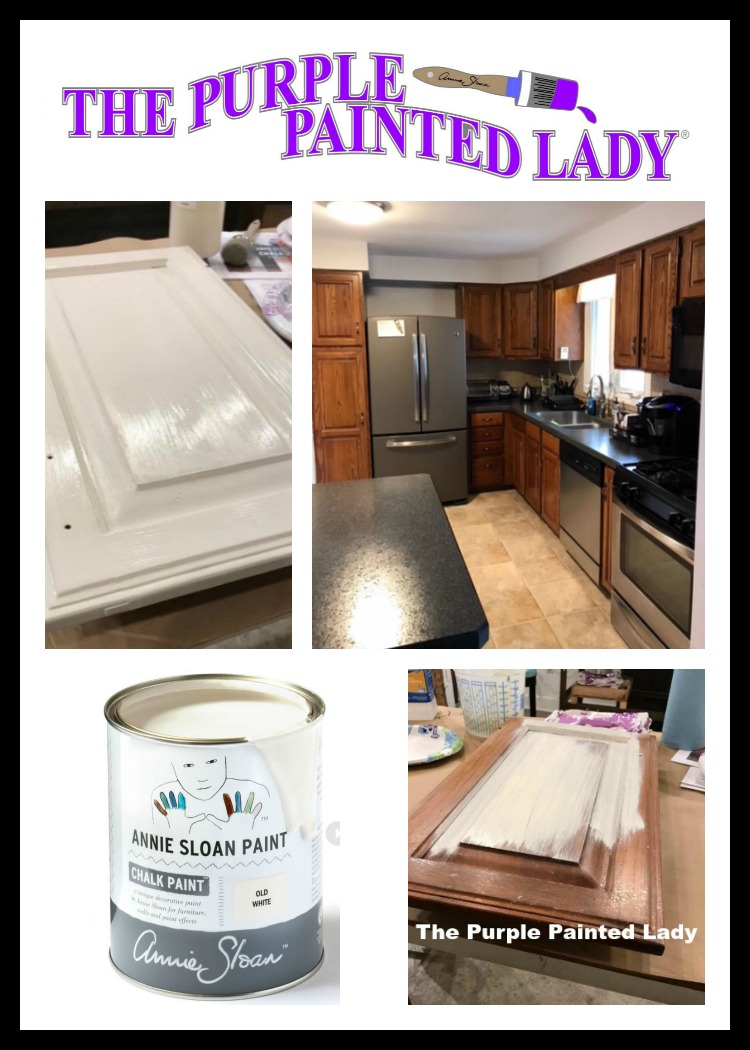
PAINTING OVER THERMAFOIL?:
We have a wonderful technical director at Chalk Paint® by Annie Sloan headquarters. She shared with us,
“The subject of painting over Thermo-Foil or other types of foil-finished cabinets comes up often. I know some of you do it and it may look good for awhile, but I really have to discourage you from doing so. These foil finishes are very sensitive to heat and moisture which can cause the foil to peel away, taking any paint finish with it. Also, paints of any kind will not bond to these materials and can eventually chip and scratch from normal wear and tear. I spoke last month at the Surface & Panel Symposium in Milwaukee which was attended by prominent printers, foilers, and cabinet manufacturers in the US and Canada. I made a point of asking various ones if their surfaces could be painted and their answer was a resounding NO. The good news is they are working on a paintable version to address the needs of the design community. The bad news … engineered cabinets with foil finishes is the future. They are being produced in various wood patterns, colors, and texture, and they truly amaze the eye and the hand. While we have been used to seeing foil finishes in white or beige applied as a sheet over solid doors, I saw it being applied to the individual components … center panels, rails, and stiles … for the more classic 5-piece constructed doors. They are making great strides in the stability of these finishes so heat and moisture problems will be a thing of the past. I believe it will be in our best interest to stress to customers that Chalk Paint® is a wonderful option … for wood and the occasional laminate cabinets.
KITCHEN CABINET PROJECT STEPS Using Annie Sloan Products
585-750-6056 www.ThePurplePaintedLady.com
This is a high level of the order on what to do…so, make sure to still read the individual instructions for paint and wax for detailed info!
1. Remove cabinet doors and number them. (Some people will paint the doors while still hanging. I don’t…but you can if you want to)
2. Remove hardware (Have an old home? – I leave the hardware in that cabinet’s cavity in a plastic bag so to know which door it goes to- keeping screws with their original hardware and doors is helpful.) Numbering cabinets can be helpful too.
3. CLEAN! Lightly Sand ONLY if you already have product or “stuff” on your cabinet that causes bumps or serious imperfections that you do not like. Spray Krud Kutter on a rag and wipe down doors –- THEN=> Using a fresh rag that is moisten with fresh water….wipe the doors thoroughly down again! <= THAT IS AN IMPORTANT STEP …allow dry time -maybe 30 minutes? Use a Scotch Brite pad if excessively dirty OR have loose paint. Denatured Alcohol or TSP can also be used, but thoroughly rinse with clean water afterward (always rinse with fresh water no matter your cleaner.)
4. IF changing the hole orientation with new hardware – Fill holes from old hardware with wood filler and sand once it is dry.
5. Drill new hole locations.
6. If you need to use shellac…use new Zinsser Bullseye Clears Shellac (spray or brush/rub on) on and allow dry time- 2 thin, uniform coats are best. If you used wood filler you will probably HAVE TO shellac the doors. Lightly sand with 200 grit. Do not break through shellac. NOTE! Most times you do NOT need to use shellac! => So, do a test by applying Chalk Paint® without shellac on one door that is seen the least,….if you have no bleeding of tannin- skip this “sealing” step. If you get bleeding after 1st coat of chalk paint®- apply shellac over paint once dry. NEVER apply shellac over wax! I like to apply shellac with a rag- NOT a brush.
7. NOW the fun part…..PAINT!: We love to use the Annie Sloan 2” Flat Brush. (this is our favorite brush to paint cabinet doors with) (https://shop.thepurplepaintedlady.com/Chalk-Paint-Flat-Brush-Large-by-Annie-Sloan_p_174.html) If painting the backs of the door- which I always do even with just one coat- paint backs first, and finish them all the way to completion using your top coat. Always “practice painting” and apply wax on the back of the doors before starting the fronts- which are the most important side of the doors, right? Want a smoother finish- thin your paint with a little water. Maybe 20%? (Paint most likely 2 coats…could be three depending on color and technique) Apply first coat and wait 24 hours…..if possible. In general, the paint dries within 30 to 45 minutes, and then you can apply additional coats, but after the first coat only- if you can wait 24 hours, do it. : ) Annie Sloan herself has always stated, never do more than three applications in a 24 hour period. that could be two coats of paint and one coat of wax, or one coat of paint and two coats of wax. It just starts to get too thick and you want each individual to set enough.
APPLYING THE SECOND COAT: I will often use my Fine Mist Spray Bottle (https://shop.thepurplepaintedlady.com/Fine-Mist-Sprayers-10-oz-Clear–Great-To-Use-When-Applying-a-Wash_p_883.html) filled with water. I lightly mist the dried paint and then immediately apply my second coat. This light mist of water acts like a slip coat and makes painting the second coat easier and smoother. Always allow ample dry time. Always end painting a section with a clean finishing stroke from end to end.
8. Number of Coats of Paint: Again…the number of coats is dependent on desired look – LIGHT sanding the surface after 2nd coat with 220 or higher grit sandpaper will create a smoother finish -ONLY IF DESIRED…but this is not required. Stay away from the edges if you do not want to break thru the paint to show base cabinet.
9. WANT A WORN DISTRESSED LOOK? Just because you use Chalk Paint® does NOT mean you have to distress to get a rustic or shabby chic look, but… if you do like that…this paint is perfect for it! So, distress edges and corners of cabinets with Annie’s sanding sponges …then blow dust off! I do this outside in the garage or outside if nice weather.
10. Seal and Protect Your Cabinets: Top coat the cabinets using Clear Wax (2 coats is optimal – (follow our wax instructions!!!) Make sure you can glide your hand on the wax surface after removing excess wax. If using Dark Wax or making a glaze – apply after 1st or 2nd coat of clear wax. Try using Annie’s FINE Sanding Pad on the wax surface after it has cured to get a shinier finish- use with GENTLE pressure. Dark Wax is the last step of your whole project. Unless you are using Metallic Gilding Wax to embellish details- then the gilding goes on last.
INTERESTED IN USING A SPRAYER FOR YOUR CHALK PAINT® in Liters?:
If using a Fuji Q4 Platinum sprayer – here are a few things learned be a fellow stockist:
1. They used a 1.3 mm tip and have changed to a 1.8 mm tip since they found it works much better. Because the paint is a lot thicker you will definitely need different tips than you were using with the paint that was packaged in quarts”
2. Warming the paint helps and thinning with warm water also works. Thinning about 10% to 20%. (start with the lesser, but you can add more paint if you add too much water)
3. Having the shop and doors heated to about 70 degrees makes a difference. So, work in a reasonably warm space. And this is not while you are in it. The space should be kept at this temperature consistently prior and for the entire cure time!
4. Also playing around with the sprayers spray pattern settings was needed.
Additional IMPORTANT Sprayer Information for Chalk Paint® by Annie Sloan:
ADDING A PAINT EXTENDER:
You can also add a paint extender to the Chalk Paint® to help get a smooth finish. We reached out to Annie Sloan Interiors and they shared that they have used XIM Latex Extender with good results in the past. Don’t let the name fool you- there is no Latex in Chalk Paint®. This product is meant to be used with any water based paints and Chalk Paint® is water based. The one in the picture below is the one Annie Sloan Interiors referred us to use, but others are available. Their spray consultant guys tell them that the main ingredient of these extenders is propylene glycol and that you can effectively make your own extender using this ingredient. Personally, I would just suggest purchasing the product pre-packaged and ready to go.
Even though you have added water as stated in the previous step – you still dilute with water AND add the extender – if you find it’s too thin to spray you can always add more paint. Don’t get too hung up on the amounts – the spray guys we work with just eyeball it!
